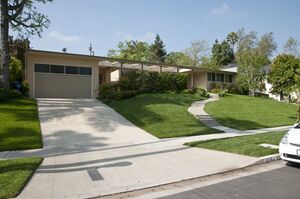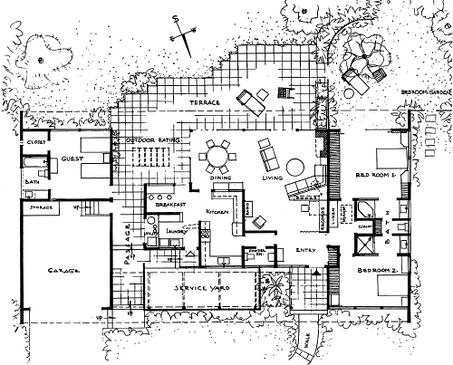Inscríbete y crea tu propia colección de obras y artículos
Diferencia entre revisiones de «Case Study House Nº 1»
Ir a la navegaciónIr a la búsqueda
Sin resumen de edición |
Sin resumen de edición |
||
| Línea 3: | Línea 3: | ||
Proyectada por [[Julius Ralph Davidson]] en 1947, es una variación de su primer proyecto presentado y publicado por la revista de John Entenza en 1945. | Proyectada por [[Julius Ralph Davidson]] en 1947, es una variación de su primer proyecto presentado y publicado por la revista de John Entenza en 1945. | ||
<!-- | |||
This one-story house was constructed on a gently sloping lot elevated several feet above street level | |||
in the prestigious Toluca Lake tract. Other homes by significant mid-century architects are in the | |||
immediate neighborhood. Case Study House #1 introduced architectural elements that came to | |||
characterize the program such as floor to ceiling glass, flat roof, open floor plan, a minimum of | |||
hallways, flexible multi-purpose rooms, immediate access to gardens from all major rooms, and use | |||
of standardized materials such as concrete block, plywood panels and industrial glass. | |||
Planar walls shield the house from the street while orienting the public living rooms to rear gardens | |||
for privacy. The plan, materials, and siting of the house encourage a relaxed lifestyle based on | |||
indoor-outdoor living. The dwelling is of wood frame post and beam construction on a concrete slab | |||
foundation. It is approximately 2000 square feet in size with a large combination living and dining | |||
room overlooking the rear gardens and pool through floor to ceiling windows. There are three | |||
bedrooms, two bathrooms and a kitchen. | |||
The primary front entrance is approached via a pathway through a grassy yard and a covered | |||
canopy. It opens to a formal entry hall leading to the bedrooms and to the common living areas. A | |||
wood fence behind high foliage hides the door leading to the kitchen and pantry off a private patio | |||
and garage side door. The two-car garage is to the left of the kitchen patio. | |||
The dwelling has a large living room open to the dining area that faces the pool and back garden | |||
through floor to ceiling sliding glass doors. A large fireplace decorated with rock veneer and a | |||
decorative sliding screen anchors the end of the open area. The opposite side of the open common | |||
area has blond plywood built-in cabinets and a decorative lattice separating it from the kitchen and | |||
entry hall. | |||
At one end of the house are two bedrooms. The smaller one is called the nursery and faces the | |||
street; the large bedroom faces the backyard. A bathroom with a common sink and bathtub separates | |||
them. At the other end of the house past the common areas, is another bedroom with built-ins and a | |||
full bath decorated with tile. The two bedrooms have built-in cabinets and closets that resemble those | |||
found in ship staterooms, since architect Davidson had designed ship interiors. | |||
The windows throughout the house are either floor to ceiling sliding glass or metal frame casements. | |||
The bathrooms have casement clerestory windows. Door and cabinet hardware is original throughout | |||
the house. Cabinets in the common areas are original blond plywood. Interior walls are plasterboard. | |||
The house is essentially original and unmodified with the sole exception being the addition of a small | |||
music studio behind the garage that is not visible from the street. As a result, the house exhibits a | |||
high level of integrity of design, workmanship, and materials. The residence is in its original location | |||
and its setting has been retained. Integrity of association is high because of its continued use as a | |||
single-family residence. Because of these factors, integrity of feeling remains strong. | |||
--> | |||
<br clear=all> | <br clear=all> | ||
==Planos== | ==Planos== | ||
Revisión del 13:36 16 nov 2013
Case Study House Nº 1, situada en 10152 Toluca Lake Avenue de Los Ángeles es la primera de una serie de casas que a través de la revista Arts & Architecture fueron publicadas durante los años 1945 a 1964 como experimentos de diseño y construcción de casas modelo baratas y eficientes.
Proyectada por Julius Ralph Davidson en 1947, es una variación de su primer proyecto presentado y publicado por la revista de John Entenza en 1945.






